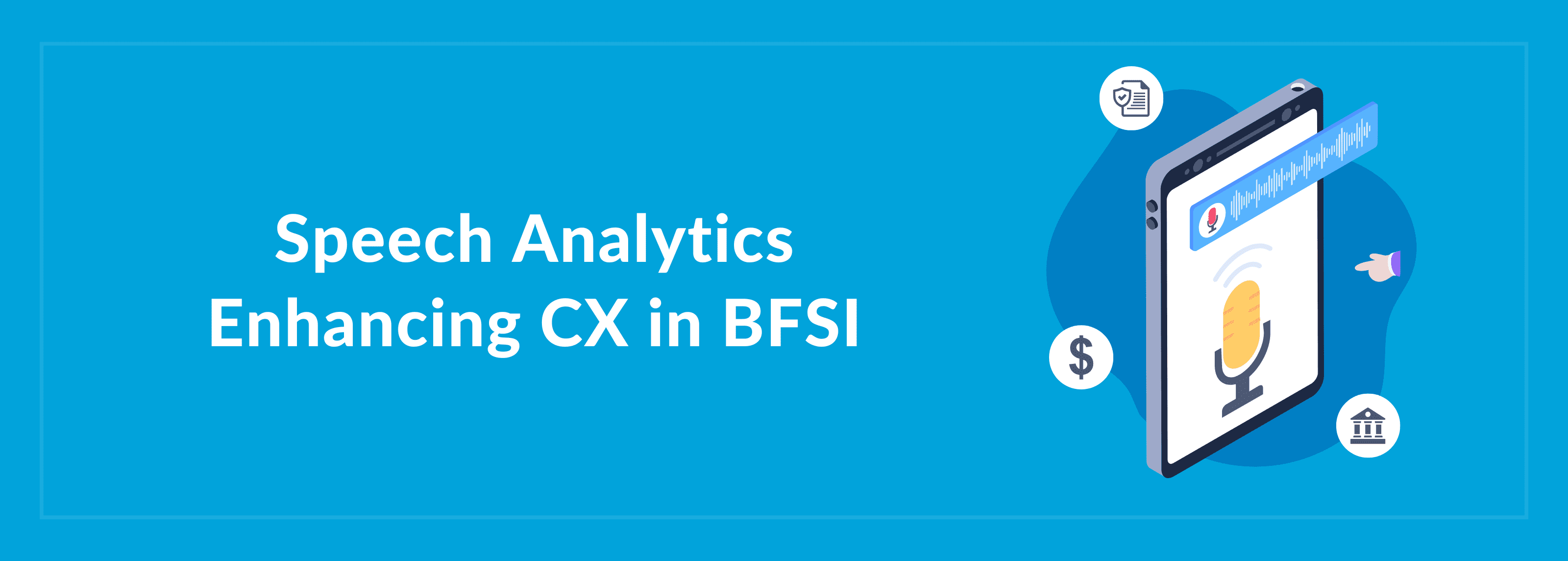Voice Analytics Enhancing Customer Experience in the Banking and Financial Services Industry
Today’s biggest challenge facing the BFSI industry is to stay engaged with the customer. A Gallup report states that fully engaged banking customers bring 37% more annual revenues.
The bottom line is engagement.
How do you keep your customers engaged?
Customer service is the fulcrum of BFSI operations, and it would be the answer to all the industry’s engagement issues.
Example of a Banking Customer
A customer opens a salary account, transacts, and later takes a five-year auto loan and a 15-year home loan. After repaying both, the bank keeps offering irrelevant loans, unaware that he has started his own business.
With access to his social media or a relationship manager tracking his needs, the bank could offer relevant startup and business loans.
Over 90% of banking interactions happen over voice. How can banks use this data to enhance engagement?
Omnichannel analytics is incomplete without voice analytics. Let’s explore its role in BFSI customer experience.
How Voice Analytics Works in a BFSI Environment
In a 5-minute call, more than 2000 words are exchanged between a customer and the contact center executive. This would include positives and negatives, which can be derived from the words and phrases used, the uncomfortable pauses, and the sentiments involved during the call.
All the calls in the banking environment get stored. Managers and supervisors of contact centers listen to only 2% of the recorded calls unless something unfavorable happens. Often, the adverse happenings are seldom reported.
What happens to the remaining 98% of the recordings?
They just sit on the storage servers and get listened to only when there are complaints. Then you identify what went wrong, but then the damage is already done.
Banking contact centers are leaving a lot of money on the table without an enterprise-grade voice analytics solution.
Assuming that you have a voice analytics solution in place, the scenario would be completely different.
When you run voice analytics on all the stored calls, you will be able to identify the customer concerns and their expectations. You can rapidly analyze call recordings to identify compliance issues, misselling, privacy issues, and newer requirements.
This would allow you to improve your customer engagement with the customers and figure out opportunities to upsell them.
Let me give you a couple of use cases for which we used voice analytics in the BFSI sector.
Identifying Self-Service Options
When the pandemic struck, the call volumes at a bank’s call center went up drastically. They were moving their agents to work from home, and the call volumes were increasing. So, the time they took to resolve customer queries went up, which made their customers unhappy.
They decided to automate their processes to handle their customer queries better. There wasn’t any consensus on what could be automated. Voice analytics of their calls revealed the commonly asked straightforward transactional queries, and they took those up for their first level of implementation.
This helped the bank set up self-service tools on their digital platforms. It brought down the number of calls that the call center was receiving, and it helped in addressing their customer queries faster and better.
Compliance Issues
Insurance selling is a regulated industry, and you will have to make sure that the customer understands all the required disclosures during the sale. Besides, you can’t incentivize a customer during the insurance purchase.
One of the insurance firms was reaching out to many prospects, but the sale closures turned invalid. When the voice analytics platform assessed the recordings, it glaringly revealed that the sales reps were not reading the required disclosures during the sale. This is a red flag process, and the sale loop wasn’t closed.
It also allowed the insurance firm to figure out the specific reps who weren’t doing this and helped create a training plan for those agents.
Why Is Voice Analytics Gaining So Much Ground?
The agent may not be aware of the growing ire of the customer, but the computer recording the call would. It can even analyze if a customer is irritated, stressed, or plain disappointed with their interaction with your bank.
Using big data techniques combined with voice analysis, your bank can get important business insights by analyzing a massive volume of call data.
How Does a Voice Analytics Solution Work?
Voice analytics uses audio from recorded calls and converts them into structured data for searching and analyzing. The tools also utilize other associated data, such as customer profile information or when the customer interaction occurred. A text transcript is also extracted from the call.
Its features include advanced search and filtering, enterprise-grade speech recognition and transcription, contextual call playback data, tagging and commenting, transcript visualization, and full PCI redaction.
The search works in a custom fashion. It includes a highly flexible search engine for quickly and easily finding and retrieving calls through free-form combination of keywords, phrases, acoustic measures, filler words, and call metadata.
I guess every organization in the BFSI segment should have voice analytics as a part of their customer engagement and experience initiatives. It would be a goldmine of information that you can use.
Overall, What Can Voice Analytics Throw Up for Your Organization?
- Identify sales conversion drivers and deterrents
- Build, monitor, and measure customer engagement index
- Real-time tracking of agents’ performance and ensuring agent compliance with protocols
- Ability to cross-sell and upsell to your customers
- Understand the requirements of your customers and identify newer opportunities
- Ensure regulatory and statutory compliance
- Act as an input to enhance agent training in your contact centers
